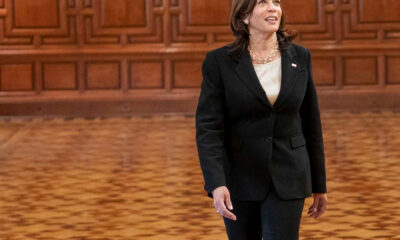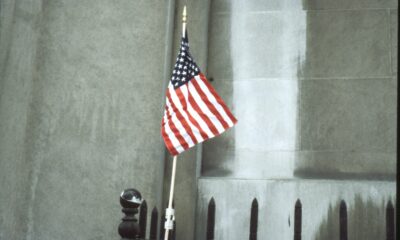Constitution
France votes on paper – why can’t we?
France conducts almost all its elections on paper, and can still report results within twenty-four hours. Here’s how.
Yesterday afternoon, Dick Morris briefly suggested that the United States change its voting procedures – or rather, change them back. Back, to be specific, to hand counting of paper ballots. He has lost confidence in the experiment with electronic voting machines – because the public has. For inspiration on what to do instead, he looked to France – where voters vote on paper and results are available within twenty-four hours. If France can do it, he asks, why can’t we Americans do the same? That’s a good question – and to answer, we can look at exactly how the French run their elections.
Your editor’s qualifications for this discussion
Your editor has been an Officer of Election in three jurisdictions, one in New Jersey and two in Virginia. When he started, “poll books” containing the role of voters in a precinct consisted of three-ringed bound volumes separated into two ranges of the alphabet. Voters cast their votes on Print-O-Matic mechanical voting machines. In the intervening years, the Print-O-Matic machines have fallen out of use. Electronic vote recorders succeeded to these, and electronic scanner-tabulators replaced those. The paper poll book has given way to the electronic poll book. Its present form consists of a server and two or three tablet devices that communicate with the server by a Bluetooth® connection. (Thus voters no longer need to separate themselves into the A-Ks and the L-Zs.)
Your editor never saw an election as “messy” as those in Atlanta, Georgia in 2020 or Phoenix, Arizona in 2022. But he is familiar with dead or moved-out voters who still receive sample ballots at their last addresses of record. So the votes of the dead and the move-outs do present a serious problem – because no one knows how many there are.
History of election procedures in America
The History Channel has an instructive essay on the different ways Americans have voted since American independence. For fifty years, voters walked down to their courthouses and cast their votes by voice. Judges were the first Officers of Election and would have each voter swear under oath as to his identity. (The his is deliberate; the laws allowed only white men to vote, and usually those who owned land.) Campaigning could take place, and sometimes liquor flowed freely. Turnout averaged eighty-five percent.
Paper ballots appeared after this, but only as blank sheets on which a voter would write the name of his candidate (or “Yes” or “No” on a public question). But then the two parties started printing literal tickets listing their candidates’ names. Voters could literally drop those tickets into the ballot box. So most voters voted a “straight ticket,” since that was easier. Naturally the Parties took the greatest care to select candidates at the “top of the ticket.” Few voters even cared to look carefully down-ticket.
In 1888, the Departments of State in New York and Massachusetts adopted the first non-partisan paper ballots. This solution came to America from Australia. The ballot listed all candidates on all races, plus any public questions and the answers “Yes” and “No” on each. For the first time, officers of election handed out these ballots.
How this made paper ballot counting next to impossible
Counting those first paper ballots must have turned into a logistical nightmare. Lower-level Officers of Election now handled each ballot as many times as the total number of races and public questions. The History essay doesn’t say this, but usually only one fair way exists to count paper ballots. The Chief OOE splits the ballots among pairs of counters. Each counter counts his ballots, and then exchanges his pile with the other member of the pair. Then each one counts the second pair. By this method, the OOEs count the ballots twice. When two OOEs have independently counted a stack of ballots, and arrived at the same answer, then and only then do they report their totals.
Imagine doing this in an election with races for:
- Electors of President and Vice-President,
- One each U.S. Senator and Representative,
- One each State Senator and Delegate/Assembly(wo)man/Representative,
- Three city, town or village council members, and
- Two public questions.
Depending on how that municipality elected its council members, that’s eight to ten races and public questions. Elections might take three days to settle. Worse, by then the OOEs might have inadvertently spoiled one or more ballots from rough handling. Elections have turned on single digits of votes. The recent public question in Wallowa County, Oregon, to decide whether the County Court must bring up interstate secession at every meeting, came down to seven votes.
Enter the voting machine
To solve that nightmare, Jacob H. Myers invented the first voting machine. This was the Print-O-Matic machine that was in service as recently as the first decade of this century.
A Print-O-Matic machine presented a face of levers to the voter, together with Party levers to pull all that Party’s candidates at once, and a long red handle at waist height, or a vertical handle hanging from the curtain rod that drew curtains over the voter, thus hiding his choices from prying eyes. An OOE would shove in a lever to unlock the machine, and then the voter would pull the handle. This unlocked the levers and closed the curtains. After that, the voter could pull a single Party lever that would vote for every candidate of that Party. Or he could “split the ticket” and vote for other candidates instead, in whatever races he selected. Those Party levers never pulled any smaller levers for Yes or No on a public question.
When the voter was finished, he would shove the handle back to its original place. This would open the curtains, count all votes, and reset all levers.
Toward the end of the twentieth century, Party levers disappeared. Thereafter “voting a straight ticket” was no easier than “splitting the ticket.”
At close of polls, an OOE would slip a hand crank onto a capstan and turn the crank to print out a large sheet containing the results. Chief OOEs would then carry these sheets back to City Hall.
From mechanical to electronic
The twenty-first century saw the introduction of the first electronic voting machines. The simplest type replaced the face of levers with a membrane. Voters would press the appropriate spot on the membrane to vote for a candidate (or Yes or No on referenda). These machines provided no paper trail. Other electronic machines featured touch screens that registered a voter’s touch at an appropriate spot. This created an immediate complication: voters have noticed one Party’s ticket displayed by default.
Of the punch cards that created the infamous controversy in the Election of 2000, the less said the better. Bush v. Gore, 531 U.S. 98 (2000).
Most jurisdictions today use scanner-tabulators to count ballots. Those ballots are either marked by hand or come from a Ballot Marking Device (BMD) that produces a paper ballot from the voter’s choices. That’s all very well, if the BMD produces a human-readable result. But in Fulton County, Georgia it produces a Quick-Read code that only a machine can read. The infamous Suitcase Scandal of 2020 has caused voters to suspect dirty work with those BMDs. They have sued the county in federal court. Recently a court-appointed expert filed a report saying someone could “hack” the BMDs, and neither voter nor OOE would be any the wiser.
This is why Dick Morris recommends abandoning electronic voting machines. While he is not willing to say these machines are inherently suspect, he knows that voters have lost confidence in them and might never get it back.
How they run elections in France
We now turn to how France runs its elections. France allows people to vote in France proper and in certain overseas French territories. They include French Guiana (home of the infamous prison system where Henri Charrière, Alfred Dreyfus, and others “did time”), Guadeloupe, and Martinique.
A citizen of France must be eighteen years old or older to vote. Registration is automatic when a voter turns eighteen but can lapse. Voters who fail to keep their registrations current, may not vote. France does not allow same-day registration. Nor does France allow mail-in voting. France abolished that in 1975, for fear of fraud. (See this article in Breitbart.)
A voter receives, either in the mail or at check-in, certain bulletins, or ballot papers, each with a candidate’s name. After checking in, a voter receives an envelope (two if he’s a proxy for another voter). The voter enters a booth, places his choice of bulletins into the envelope, seals it, then moves to the ballot box. Their equivalent of a Chief or Assistant Chief OOE formally checks the voter’s identity at the box. When satisfied, the chief opens the box and lets the voter insert the envelope. Thus each voter must pass two identity checks: at check-in and at the ballot box. (The chief may waive identity check if he knows the voter in a small town having fewer than 1000 residents.) Then the chief announces, “Voted!” (Literally, A voté!)
Voters in the territories may vote by Internet.
In France, someone may vote instead of you
France does not allow early voting, either in-person or by mail. So how does a voter cast his vote if he knows he can’t show up to vote? By selecting a proxy. (A voter may even do that if he’s confined to jail while awaiting trial – but not after conviction.) The voter and his proxy (who must be from the same administrative district, or commune) typically must register together before:
- A judge or clerk of the court, or
- An officer of the police judiciaire. This is the criminal police of France.
A voter living abroad can appear before the French ambassador or consul in the area. If the voter is ill, the police judiciaire can come to the voter’s house.
The proxy then carries out exactly the same voting procedure as the voter himself would (and as he himself does to vote in his own name).
According to Breitbart, as many as seven percent of the electorate voted by proxy in the Presidential election of 2017.
France does not uses ranked-choice voting, either! Instead they have a two-round runoff system. The two top vote-getters advance to a runoff – and runoffs are always necessary in France.
After the election, volunteers count the bulletins and report the number of votes for each candidate. From long experience, the French have put in place certain efficiencies that let them count votes quickly. (But apparently, they do not allow write-in candidates, either.)
Can we do it in America as they do it in France?
To run elections in America as France runs them, would require a few minor adaptations. Provision for write-in candidates is an obvious refinement. The pre-printed ballot papers do allow someone to specify a candidate easily and with no confusion. But American jurisdictions accept write-in ballots today. This is easier in some jurisdictions than in others. (The old Print-O-Matic machines provided slide-open windows for writing in a candidate’s name on the Big Roll.)
That seven-percent figure for proxy voting is important. At least one activist has suggested disallowing absentee balloting entirely. “How often is someone not able to vote on Election Day?” this activist asked your editor, not without some scorn. The answer: up to seven percent. And even if one voter couldn’t make it, better to preserve his franchise. The Greater Idaho Movement would beg to differ with any activist who insisted that abolishing absentee voting would not make a legitimate difference in outcomes.
Fortunately, the French have the solution. An American voter could register himself and his proxy at the local police precinct or sheriff’s office. Involving a law-enforcement officer, or an officer of the court, addresses the obvious matter of security.
France is a country of 68 million people – 65 million living in “metropolitan” France (France proper) and another 3 million living in “overseas” France. If a country that size can turn elections over in twenty-four hours, any State within the United States can do the same. So the answer to “why can’t we,” is: we can.
Terry A. Hurlbut has been a student of politics, philosophy, and science for more than 35 years. He is a graduate of Yale College and has served as a physician-level laboratory administrator in a 250-bed community hospital. He also is a serious student of the Bible, is conversant in its two primary original languages, and has followed the creation-science movement closely since 1993.
-

 Guest Columns4 days ago
Guest Columns4 days agoCHAPTER 42: Quantum Computing Empowers Technocracy, Transhumanism, and the Managerial Unistate – Space Is No Longer the Final Frontier—Reality Is*
-

 Executive3 days ago
Executive3 days agoCHAPTER 43: Ideological Subversion, Communitarianism, and the 15-Minute City – Space Is No Longer the Final Frontier—Reality Is*
-

 Executive4 days ago
Executive4 days agoHow Trump Rewired the Rust Belt Voter
-
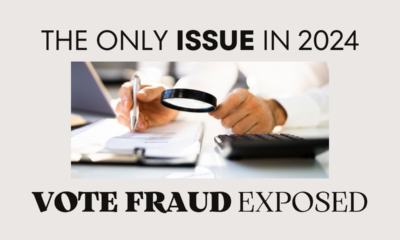
 Civilization3 days ago
Civilization3 days agoVoter Fraud—The ONLY Issue That Matters in 2024
-
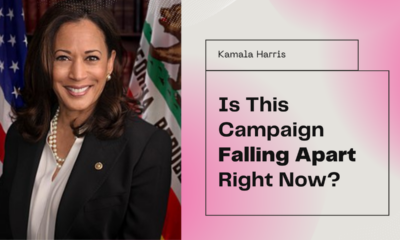
 Civilization1 day ago
Civilization1 day agoKamala Harris campaign dying
-
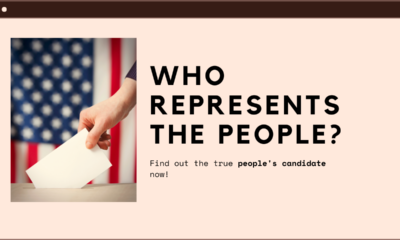
 Civilization2 days ago
Civilization2 days agoReal Candidate of the People?
-
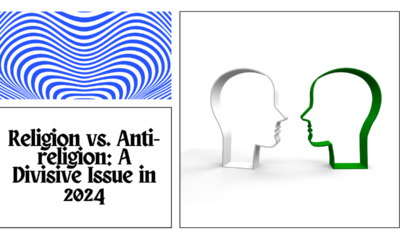
 Christianity Today3 days ago
Christianity Today3 days agoThe Religious Divide
-
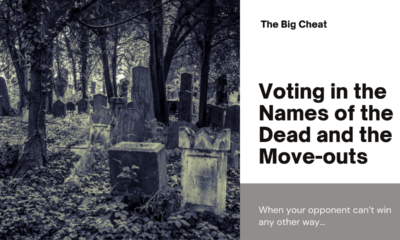
 Civilization4 days ago
Civilization4 days agoThe Big Cheat – how it could happen





